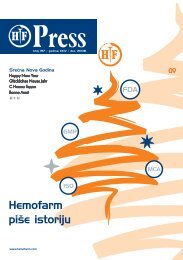NEW HEMOFARM PREPARATIONS TO APPEAR SOON
NEW HEMOFARM PREPARATIONS TO APPEAR SOON
NEW HEMOFARM PREPARATIONS TO APPEAR SOON
You also want an ePaper? Increase the reach of your titles
YUMPU automatically turns print PDFs into web optimized ePapers that Google loves.
ACE inhibitors and losartan, it turned out that the incidence of cough as an adverse effect, was significantly decreased in<br />
the case of losartan as compared to the ACE inhibitors.<br />
For which diseases are the other new preparations intended?<br />
The existing number of preparations within GastroLogica has been enriched with the introduction of two new preparations.<br />
Those are Bicit HP, by composition bismuth subcitrate and Sabax, which is by composition lansoprazol, i.e. belongs to<br />
proton pump inhibitors.<br />
What are the exact indications in which the above mentioned preparations will be used?<br />
Both preparations have their place in the therapy of the very frequent ulcus disease (ulcers) and the eradication of the<br />
Helicobacter pylori. The peptic ulcus disease (ulcer on stomach or duodenum) is among the most frequent gastrointestinal<br />
diseases. It is diagnosed in about 10% of the world population, but it is assumed that the actual prevalence is probably<br />
greater. Namely, part of the patients without expressed symptoms do not go to doctors, but treat themselves. It has been<br />
noted that the frequency of the peptic ulcus disease in the last decades is decreasing gradually, particularly of the one on<br />
duodenum, and the number of serious complications is also decreasing, particularly bleedings. H. pylory infection<br />
increases significantly the risk of the devleopment of the peptic ulcus disease ( 4 – 10 times), regardless of the fact whether<br />
it is a question of the stomach ulcus or the ulcus of the duodenum. The etiological meaning of H. pylori infection is best<br />
reflected in the fact of a faster healing of the ulcus and significantly less frequent recidives following successful eradication.<br />
Namely, the frequency of the ulcus recidive, of 70 – 80% in the course of the first year in the case of the untreated drops<br />
below 5% in patients following the eradication of the infection. For example, following the achieved sanative effect, mainly<br />
all ulcus recidives on the duodenum are a consequence of the infection with H. pylori<br />
The knowledge about the benefit of the eradication of the Helicobacter pylori (H. pylori) particularly in patients with peptic<br />
ulcus, has led to great and significant changes in the treatment ot stomach and duodenum diseases and has absolutely<br />
changed the conceptions and treatment of patients. Eradication has been defined as the disappearance of H. pylori from<br />
the stomach mucous tissue (negative result), determined at least 4 weeks following the end of the eradication antibiotic<br />
therapy. The therapy protocol must be simple, low cost and well endured, so that patients will implement it easily and<br />
completely.<br />
What is the real degree of success of this kind of therapy?<br />
The success of eradication of H. pylori, measured by the strick criteria, must be greater than 80%. It is recommended that<br />
the therapy be triple and not longer than 7 days. Some of the proton pump inhibitors (PPI) are used as an antisecretory<br />
medicament: omeprazol, pantoprazol or lansoprazol. Some of the antibiotics are given with this: amoxicillin, clarithromycin<br />
or metronidazol. Due to the failure of the eradication therapy and increase in the number of resistent species of H. pylori to<br />
antibiotic components of the current therapy protocols, new ways of treating and new efficient medicaments are to be<br />
found.<br />
Patients in whom eradication leads to the disappearance of the symptoms should be tested again for HP after 4 weeks. If<br />
the patients are positive, it will be necessary to repeat the treatment and this means by a combination of PPI + metronidazol<br />
+ bismuth in the form of subcitrate + tetracycline which seems to be most efficient according to information found in<br />
literature.<br />
In which way do these preparations have an effect on the above mentioned stomach disease?<br />
Bismuth subcitrate has a protective effect on the mucous tissue of the stomach and duodenum and makes a lining on it.<br />
Besides this, bismuth subcitrate has a bactericidal effect on Helicobacter pylori which is an important factor in the<br />
occurrence of the ulcus disease. Bismuth subcitrate acts together with the antibiotics which are used in the eradication of<br />
the Helicobacter pylori and can be implemented in a combined therapy of the ulcus disease (constituent part of the triple<br />
or quadruple therapy in combination with antibiotics, proton pump inhibitors or H 2 receptor blockers).<br />
Lansoprazol belongs to the group of proton pump inhibitor medicaments. The mechanism of action entails H + /K + ATPaze<br />
inhibition of parietal cells of the stomach, the terminal phase in the production of the stomach acid, which leads to the<br />
reduction of acidity and achievement of antiulcus effect. It is believed that biotransformation of lansoprazol into active form<br />
and then binding with the sulphhydrile group H + /K + ATPaze with consequential inhibition occurs on the level of parietal






